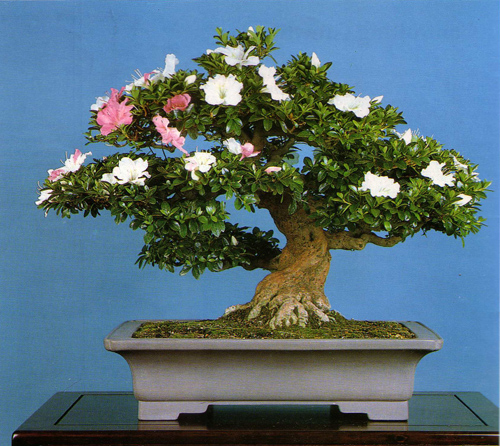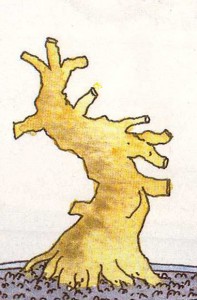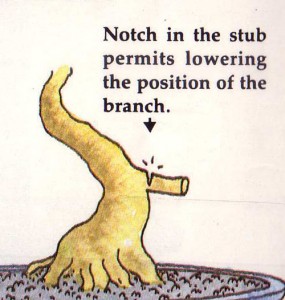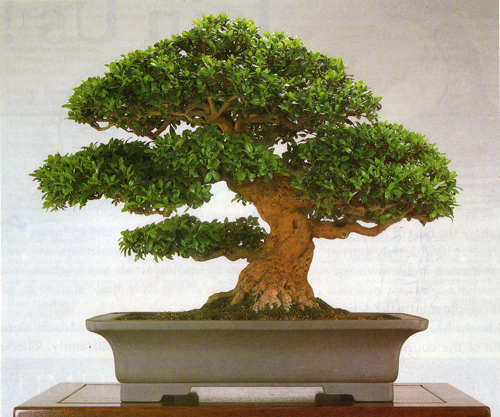
An advanced, but unfinished stage in the development of a Satsuki azalea (see below for a later photo). There are at least three flower variations shown in this photo: all white, all pink, and pink and white striped. Satsuki azaleas are renowned for their vast and varied range of flowers. The photos and illustrations in this post are from Bonsai Today issue 1. The bonsai artist’s name is not mentioned.
Azaleas are easy
Azaleas respond extremely well to pruning during most of the growing season. You can cut off all the branches and new shoots will appear from the stubs (and from practically everywhere else). You can even whack the trunk down to almost nothing and new shoots will spring forth from whatever is left (even from the roots). This and other features like small leaves (on many but not all azaleas), small and beautiful flowers (ditto) and easy adaptability to container culture, make azaleas a favorite for bonsai enthusiasts.
Can you apply the same techniques to other types of trees?
Many of the tips provided in this and subsequent azalea posts will work with other types of trees. However, bear in mind that most trees are not as forgiving as azaleas, so don’t get carried away. It’s always a good idea to know the tolerance levels of whatever type of tree you are working with.

Leave stubs where you want new branches. If a bonsai has been neglected, it might be necessary to remove the old branches and start over (don’t try this with conifers or other trees that don’t bud back on old wood). If you leave stubs where you want new branches, shoots will grow from them and you’ll have a head start.

Notching to lower brances. Normally you want branches to grow a little downward. This helps create a feeling of age (big branches tend to sag on old trees). This technique works with most types of trees, provided you don’t make the notch too deep or get careless and break the branch. Once you’ve made the notch and secured the branch’s new lower position with wire, be sure to treat the wound with cut paste.

The same tree at a later, more refined stage. Most of the changes have to do with development of secondary and tertiary (and beyond) branching. Upcoming posts in this series will provide a few tips on how to achieve this type of refinement.
For much, much more on Satsuki azaleas
See Satsuki Azaleas for Bonsai and Azalea Enthusiasts
Stay tuned for some more basic azalea tips
Perfect timing, I have a field grown Azalea ( been in my garden for about 15 years I now know what to do with it on its journey from bush to Bonsai
Thanks
I am curious about the position of the notch cut in the branch to lower it. I would have thought that making the notch on the lower side of the branch would have made the bend easier and allowed for the two sides of the notch to grow together, rather than leave the gap on the top. Just a thought.
The top notch is sometimes necessary, especially on thick branches. If you just notch the lower side the top would have to stretch in a place where it is already too thick and firm to bend. On younger branches, you don’t need notches at all. Just wire will do.
You are welcome and good luck. Stay posted for more on azaleas and send us a photo if you are so inclined.
Wayne,
The stubs look a little bit long. When I’ve had to revitalize an azalea, I cut back more severely and don’t leave such long knobs. To illustrate, on page 35 of “The Magician” (Kimura 2) that’s about how much I cut off to do a total revamp. This year I have an imported Satsuki that I will be performing this procedure on. It has a great nebari, amazing trunk, but the branches leave much to be desired.
Yeah. Some of the stubs do look a little long in the drawing. However, you can save as much of a branch as you want, depending on the taper, the angle that it comes off the trunk etc. If the first part of a branch looks good, you might even keep several inches. Or you could even keep a whole branch (or more than one) while you cut off all the others.
In any case, it’s a good technique as azalea branches can really get out of control if left alone too long.
Do yuo carry such specimens for sale? Where would I find those??
We don’t sell live plants at this time. I have some larch and juniper and a few other things growing in the ground that I may sell at some point, but no azaleas. You can just google azalea bonsai and you’ll have some choices.